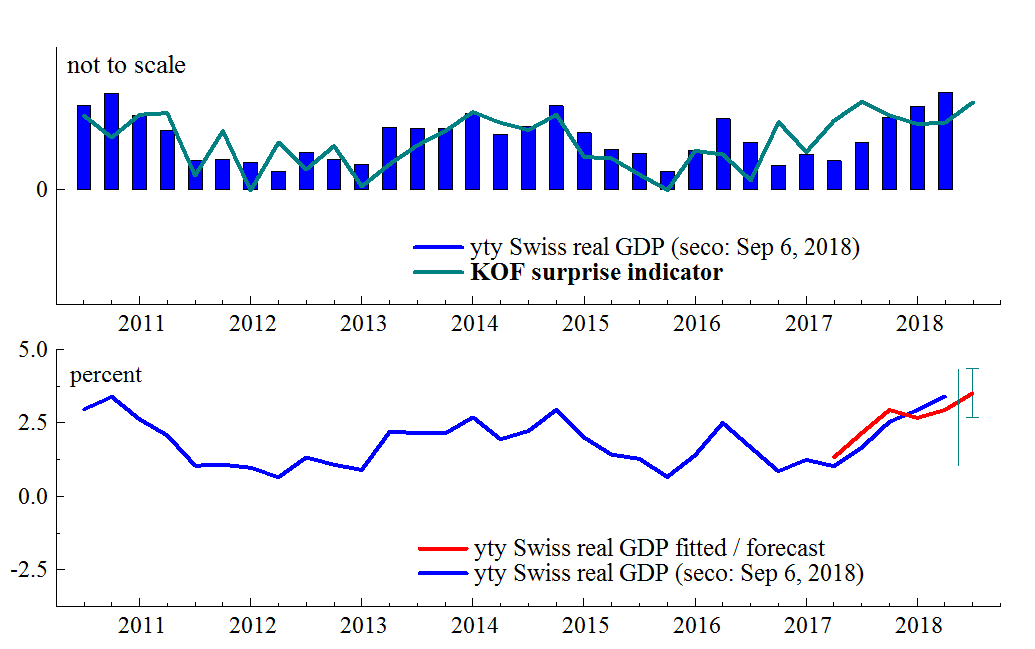| |
|
|
|
| |
T |
GDP forecast based on
semantic business cycle identification
|
TEST |
| |
|
Release
2018-11-14
|
|
| |
|
Figure 1:
Business cycle indicator based on semantic identification in comparison
to real GDP: Ex-ante forecast properties |
|
| |
|

|
|
| «home |
|
Quarterly
nowcast update. Order
your free personal quarterly email
alert with the latest GDP estimate based on the «KOF surprise
indicator». Subscribe here»
|
|
| |
|
|
|
| |
|
Forecast
update. The «KOF surprise indicator» for
measuring Swiss economic dynamics flags a healthy expansion
of Swiss value added. Its latest reading of -0.014 (up from a revised
-0.021) comes close its last high recorded one year ago.
|
|
| |
|
Based on this upbeat finding the
latest estimate for Swiss real GDP year-on-year growth amounts to 3.5
percent, after 2.9 percent three months ago.
|
|
| |
|
|
|
| |
|
Table:
Swiss real gross domestic product with
forecast |
|
|
|
|
Date
|
Year-to-year growth (%) of
Swiss real gross domestic product (GDP)
|
| |
fitted / forecast
|
standard error
|
seco estimates*
|
|
2018(1)
|
2.67
|
-
|
2.21
|
2.93
|
| 2018(2) |
2.94
|
-
|
-
|
3.40
|
| 2018(3) |
|
0.42
|
-
|
-
|
|
|
| |
|
Sources: Own calculations, forecast
for 2018(3), fitted values otherwise, *seco releases (left: May 31, 2018, right: September 6, 2018).
Sample: 2000 (2) - 2018 (2),
Forecast: 2018 (3)
Note: Forecast obtained by best
nowcasting model.
|
|
| |
|
|
|
|
|
Outlook.
During
the past six months the Swiss economy has enjoyed strong tailwind from
domestic investment, a comparatively weak currency, strong export
demand and robust consumption. On top of all this, the re-structuring
of the economy in the wake of the currency shock seem to pay a
decent dividend.
|
|
|
|
At the same time neither increased
tariffs, fiscal
and legal struggles within the European Union with their latent crisis
potential, nor the German carmakers' drop in output due to the diesel
scandal could hamper Swiss economic performance. |
|
|
|
Beyond this rosy picture, some
clouds are clearly visible, however. Today, Germany has posted its
first quarterly loss
in output in three years, Italy's budget crisis remains unresolved,
the US trade policy concerns have not yet faded and overblown real
estate prices in Switzerland pose a permanent threat to domestic
financial stability. |
|
|
|
Finally, seco's most
recent data revision may not only have resolved the puzzle of
2017's weak growth but has probably also drawn a little too optimistic
picture of the first half of 2018. Consequently, the current economic
boom may be strong and robust but not as strong and as robust as the
official figures suggest. |
|
| |
|
|
|
| «home |
|
|
|
| |
|
*Standard error of regression refers
to baseline model published in the first release. |
|
| |
|
|
|
| «home |
|
Special
feature: Severe data revision. Each
summer, the Swiss State Secretariat for Economic Affairs (seco) swaps
its indicator-based preliminary estimates of previous year's GDP figures for the first data release by the Federal Statistical
Office (FSO). Each summer, this move
re-writes the recent economic history; sometimes more so and sometimes
less. The summer 2018 stands out, however, because all previous
revisions pale against the 0.5 percentage point boost
to annual growth. Even more strikingly, this revision not only exceeds
the correction owed to the great recession of 2009, it is also the revision
that many did
see coming.
Read here what caused the seco
revision, to what extent seco's early, imprecise estimates affect GDP
nowcasting and why the «KOF surprise indicator» made
sure that neither the revision nor its extent came as a surprise.
|
|
| |
|
|
|